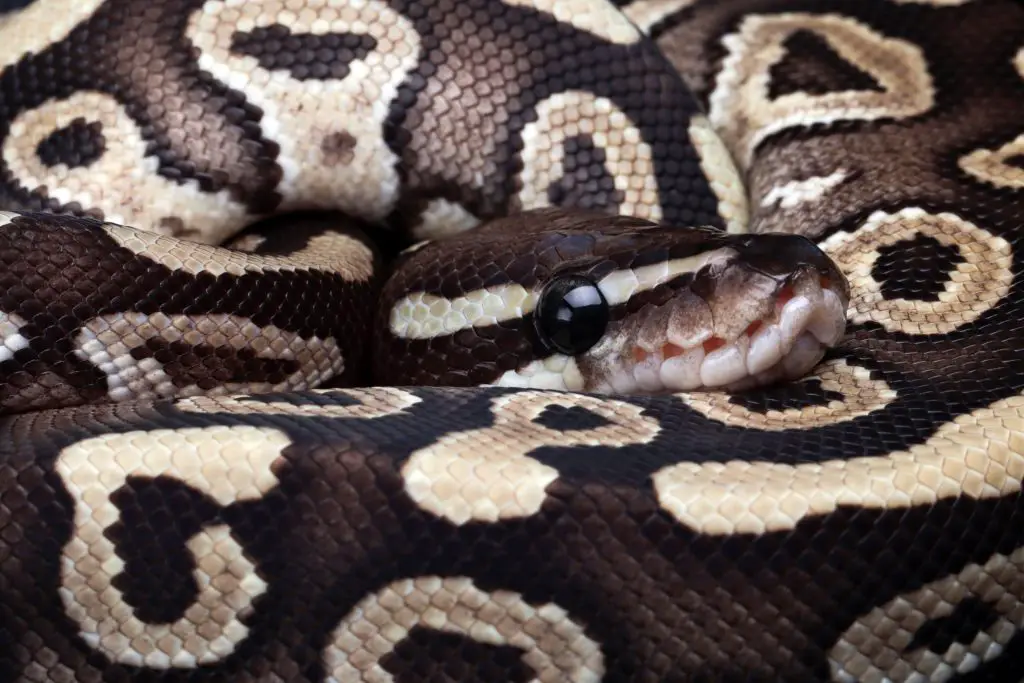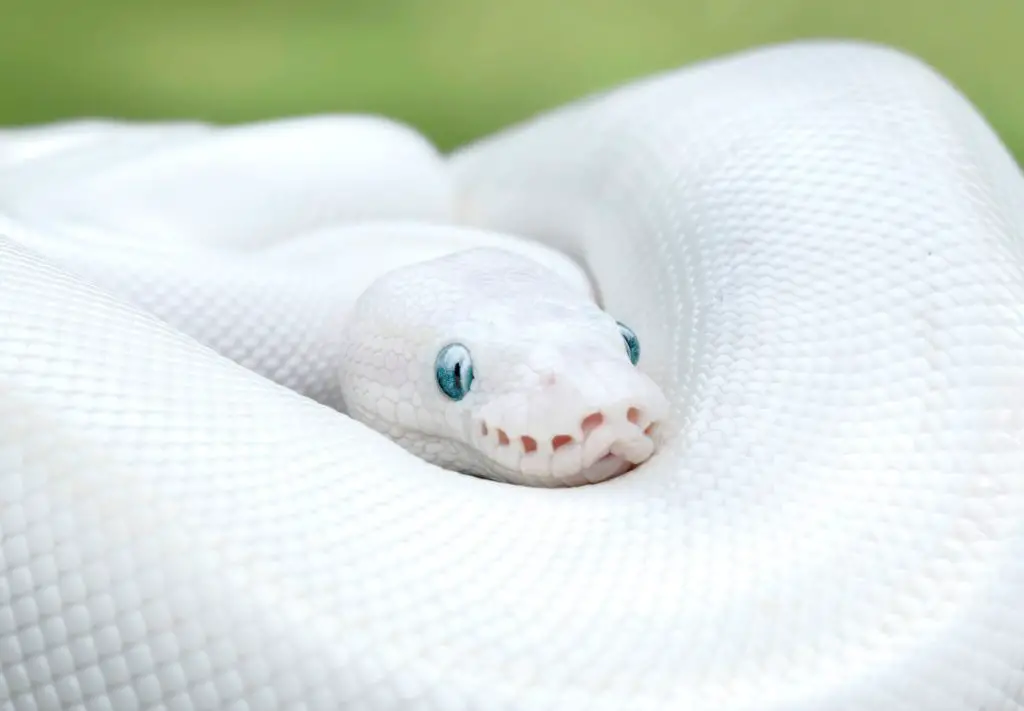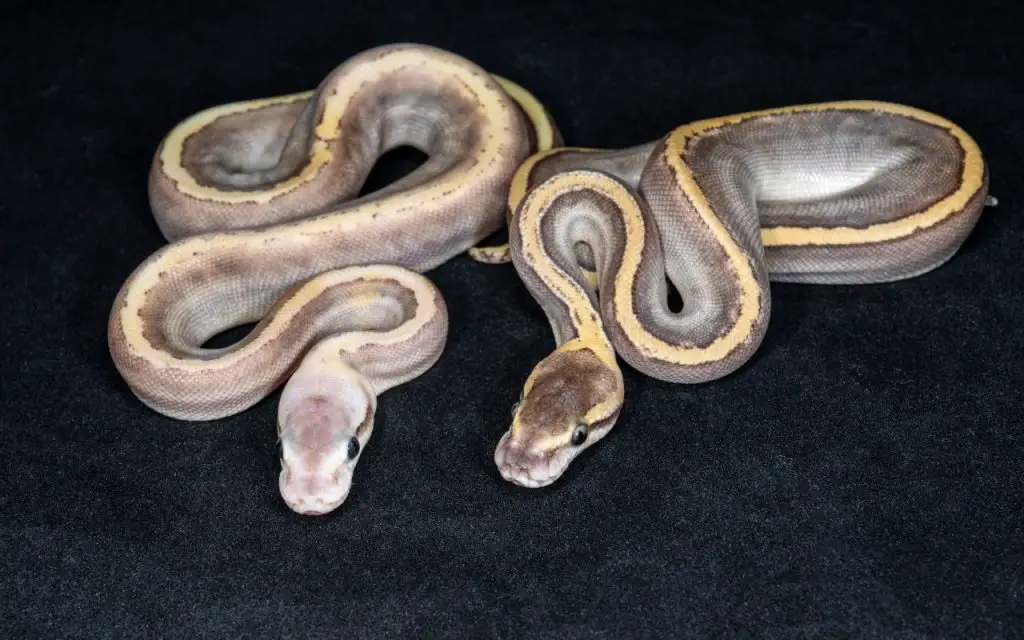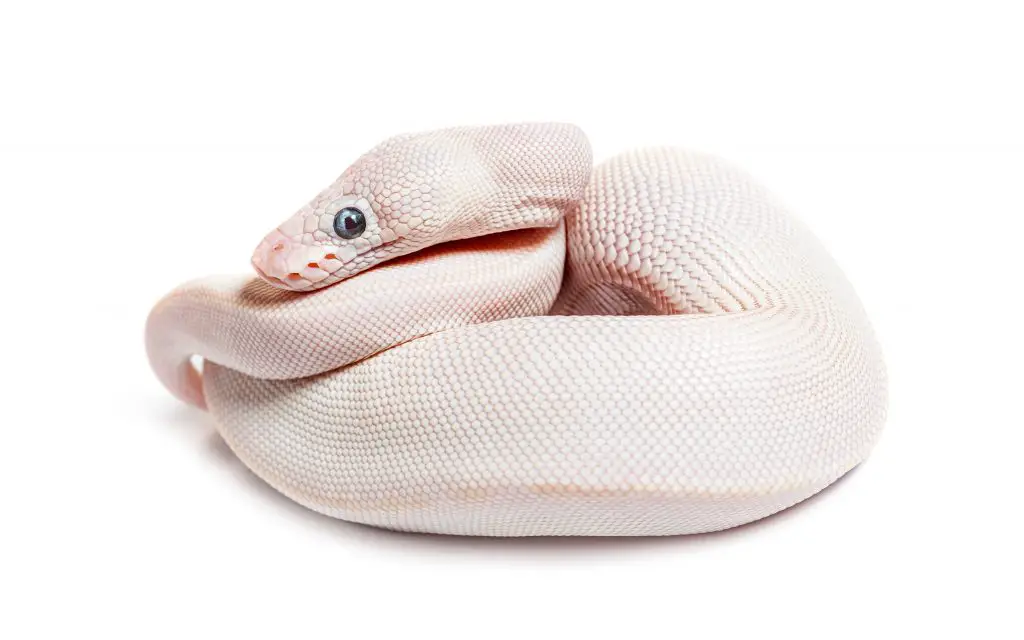Brought to us by The Snake Keeper (TSK), in 2000, the Mojave Ball Python is now a staple in the hobby. Though nice as a single gene morph, it is in its super form or in combinations with dark genes that it shows its true potential.
Morph type
Mojave is a single gene incomplete dominant morph. This means that if you breed a Mojave to a normal, about 50% of the offspring will visually express the mutation. Also, if you breed a Mojave to a Mojave, you can get a super Mojave – more commonly known as a Blue Eyed Leucistic (BEL).
Description

In Mojave Ball Pythons colour, pattern and contrast are all affected. The blotches that form a normal Ball Python’s pattern are reduced in size in Mojaves, and tend to be a bright yellow, especially in hatchlings. On the dorsum, some of these blotches may form a solid stripe towards the tail and neck or be reduced to spots at mid-body.
The background is a deep brown or even black, with lighter blushing on the lower flanks. As for the head, it is generally like a normal Ball Python but darker.
The overall effect is that of a very contrasted and striking animal. As with many morphs, the overall brightness and contrast does fade a little with age. To counteract this, Mojave can be used in combination with – and enhanced by – other genes. Like Pastel, Mojave seems to work well with almost every other gene available, which is part of why it’s so popular.
In summary:
- dorsum (back) – very dark brown with sharply contrasting yellow blotches and spots
- flanks – lighter brown, with blushing between the blotches (also known as “alien heads”)
- head – dark brown on top with almost no blushing, bright yellow stripes through each eye
- eyes – black but may have brown or yellow pigment in top half or iris
- lips – white
- belly – mostly white
Does the Mojave Ball Python have genetic issues?
To date, no genetic health issues have been observed in Mojave Ball Pythons. What’s more, it can be combined with other similar genes such as Butter to make Blue Eyed Leucistics. These genes are referred to as the “BEL complex”.

Breeding tips
There are three main ways you can use Mojave for a breeding project. The first is to breed it to another Mojave and make a super. Super Mojaves are a type of Blue Eyed Leucistic that is almost pure white, apart from the head which has a grey/purple tone. These are immensely popular!
The second way is to combine it with a dominant or incomplete dominant gene like Chocolate, Acid or GHI. GHI Mojaves, for example, are quite possibly one of the most stunning combinations found so far. Or, if you like to retain a little colour, Mojave also goes well with Pastel, and this combination is known as a Pastave.
Finally, combining Mojave, a dark dominant/incomplete dominant gene and Ghost can make incredible, smoky-looking grey combos. If you add Ghost to a GHI Mojave, for example, it makes a stunning, opaque looking snake. Some of these almost look smoky-grey and are worth researching if you haven’t seen one yet.
Top 5 Mojave Morphs (my choice)
1. Super Mojave Ball Python, A.K.A. Blue Eyed Leucistic

As I mention earlier, Mojave is an incomplete dominant gene. Breed two together and you can the super form, which happens to be a Blue Eyed Leucistic – one of the most popular morphs of all time. These have been around for years, but their popular is no where near calming down. In fact, at the time of writing BELs are still going for around $500 in the U.S.
To a breeder, this is interesting because a single gene Mojave is going for around $150…
Super Mojaves are white all over, with just a hint of purple colouration on the head. As you’d expect, the eyes are subtle blue.
2. GHI Mojave Ball Python
This designer morph is one of the most stunning on the market. The dark influence from GHI makes the flanks almost completely black in some animals. Thanks to the Mojave influence, however, the dorsal markings remain a bright yellow. Overall, the result is a striking animal with a “stand-out” pattern along its back.
Another thing that makes this morph attractive is the fact that its price is in the medium bracket and won’t break the bank.
3. Banana Mojave Ball Python
Like the previous one, this designer morph is incredible to look at and now widely available. Mojave is dark and contrasting, whereas Banana is bright and colourful… Why not have the best of both worlds?
As you’d expect, the overall appearance of this morph is dominated by the Banana gene, but what makes it attractive is that Mojave gives it a whole new aspect by adding some darkness. In nice examples, the patterning retains the yellow colouration we love in Banana Ball Pythons, but the background is a rich, dark purple colour.
4. Pastel Mojave Ball Python, A.K.A Pastave Ball Python
As you probably already known, the Pastel gene adds yellow colouration and jumbles up patterning. When you add it to Mojave, the result is a more interesting pattern, more blushing in the background, and sometimes even more contrast.
With Pastel Mojave Ball Pythons being a ridiculously cheap morph – and widely available, they definitely have the most bang for your buck.
5. GHI Mojave Ghost Ball Python
Last, but certainly not least, this designer morph combines the GHI and Mojave genes with the recessive Ghost gene. It’s a little pricier, and a little more difficult to find – but very much worth it.
Whilst overall the appearance is identical to that of a GHI Mojave, the Ghost gene adds a washed-out, opaque aspect to it. The result is a smoky grey animal that is incredibly striking and subtle all at the same time.
Mojave Ball Pythons for sale
Mojave Ball Pythons are cheap and widely available. This makes them easy to find and well worth the money. In fact, I sometimes see them for as little as $60. With animals at this price, your best bet is to find a small local breeder who will let you pick up the animal yourself.
By doing this, you can avoid an expensive courier fee, and putting the snake through the stress of shipping. If, on the other hand, you want to buy a Super Mojave (B.E.L.), make sure you buy it from a well-established breeder with a solid reputation.
I say this because Super Mojaves are easy to identify if Mojave is the only gene involved – but way harder to figure out if other genes are added into the mix. Not all Blue Eyed Leucistics are the same!
Obviously this is where buying through Morphmarket becomes a good option. You can see each breeder’s ratings and leave feedback after buying.

Future of the morph
Mojave Ball Pythons are here to stay, that much is certain. Their popularity is huge, and like Pastel, Mojave seems to go well with everything. This means that breeders investing in new and rare genes often use Mojave to create new combination morphs.
If you look at the incredible Monsoon gene, for example, one of the first other genes it was combined with was Mojave. For anyone thinking of breeding, it should be obvious that Mojave is simply a good gene to have in the collection, not just for creating morphs we already know and love, but for what it might do in the future.
Mojave Ball Python Summary
| First produced by: | The Snake Keeper (TSK), 2000 |
| Morph type: | Incomplete dominant |
| Genetic issues: | None |
| Goes well with: | Mojave, dark dominant/incomplete dominant genes, Ghost |

FAQ relating to the Mojave Ball Python
What is a Mojave ball python?
A Mojave Ball Python is a morph, meaning that it displays an unusual coloration thanks to a genetic mutation. In this case the genetic mutation is on an incomplete dominant gene (also known as co-dom). This means that a Mojave has just one copy of the gene – but breed two together and you can create offspring with two copies, and this is what Blue Eyed Leucistics are.
How do you tell if a ball python is a Mojave?
There are a number of genes that look reasonably similar to Mojave. Butter and Lesser, for example, both resemble Mojave but are several shades lighter. To recognize Mojave as opposed to one of these other morphs, look for a very dark background. In this morph, the blotches of pattern should be yellow, and the background should very dark brown, not tan.
Are Mojave ball pythons good pets?
Mojave Ball Pythons are great pets. They do not have any genetic problems or issues related to their unusual coloration. In fact, they’re every bit as healthy and long-lived as regular Ball Pythons. They also happend to be cheaper than other morphs, which makes them attractive to first-time owners.
